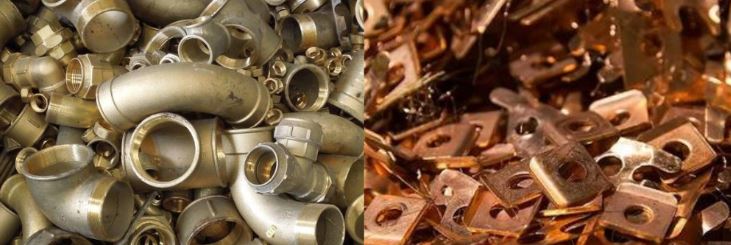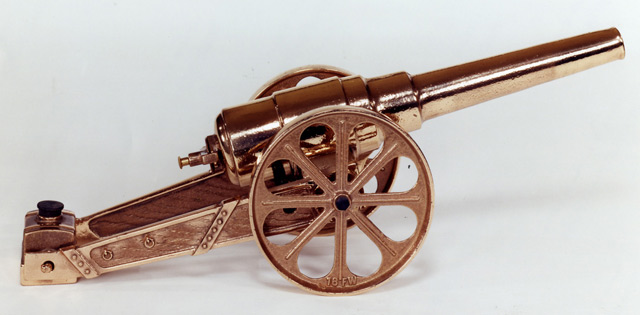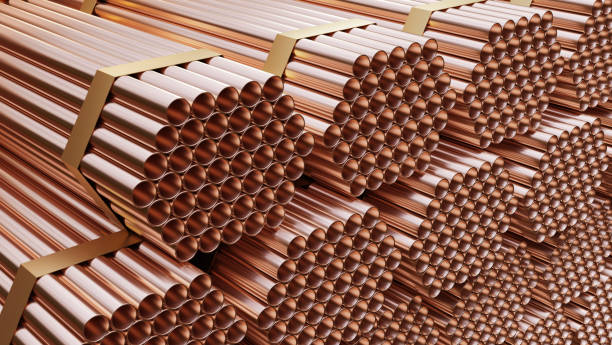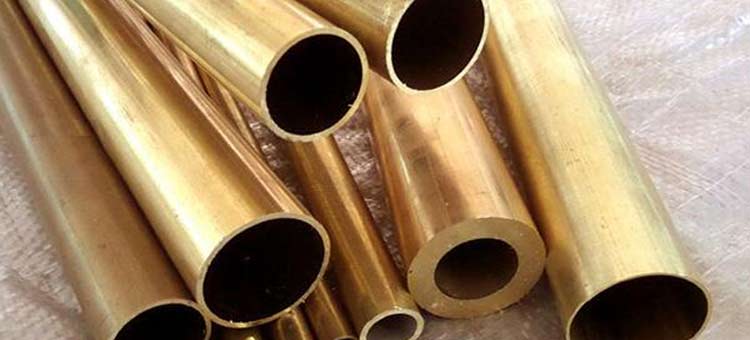Brass is an invaluable metal whose main alloying elements are copper and zinc. These alloys that makeup brass are also the differentiating factors for its derivatives, including yellow brass vs red brass. This is because yellow brass has a higher zinc content, while red brass has a higher copper content, altering their standard properties and qualifying them for various applications.

Aside from their differences and similarities in applications. Brass yellow vs red brass has other features that this variation in zinc and copper composition changes. Keep reading to learn more about red and yellow brass.
What Is Red Brass Vs Yellow Brass?
Considering that these two metals are derived from the same element, they are expected to possess the same characteristics. But the reverse is the case, as a little altercation during manufacturing can yield different types of brass materials from what you expected. Now, what is the difference between brass red vs yellow?
What Is Red Brass?
Since manufacturers started replacing brass with copper for various applications, including jewelry making and electrical switches, they have tried to come up with variations of the brass material to maximize their properties. One of their many discoveries is the red brass, copper-zinc-tin alloy, or popularly called gunmetal.
This metal alloy is a valuable material in various industries, with the exception of marine applications because the zinc reacts with seawater leaving porous copper. The reaction in seawater can be a concern, especially for individuals using red brass because it has a lower zinc content and higher copper concentration.
We will look into the chemical compositions of this metal in the preceding sections, but this doesn’t mean that yellow brass is also eligible for use in marine environments and components. This is especially because it is much more susceptible to corrosion than red brass.
What Is Yellow Brass?
Brass yellow is another metal derived from brass, having copper and zinc as its main alloying elements like red brass. Since they are coined from the same metal and contain the same alloys, one expects that they would have the same characteristics. However, this is not the result of these two metal alloys, hence the comparison.
Unlike red brass, yellow brass has a lower copper content, but higher zinc content. Remember that red brass’ reddish look can be transformed into yellow with increased zinc content, meaning that the higher the zinc the more yellowish the brass metal’s color as it is in brass yellow.
This metal contains a maximum of 80% copper, unlike the minimum of 85% in red brass, and it is also accompanied by an average of 35% zinc which is three times higher than its counterpart. The zinc content in this metal gives it excellent elasticity, ductility, and malleability. Brass is also an ideal material for CNC Machining.
Chemical Composition of Red Brass Vs Yellow Brass
The chemical composition of brass yellow vs red brass determines the application, strength, durability, and other properties. With the previous discussions, it may not seem like there’s much difference, but there’s more than meets the eye, and the table below highlights the difference in their chemical content.
| Chemical Properties | Red Brass (%) | Yellow Brass (%) |
| Copper | 85-90% | 60-80 |
| Zinc | 5-10 | 30-40 |
| Tin | 2 min | 1 max |
| Lead | 1 max | 1 max |
| Iron | 0.1 | 0.1 |
| Manganese | 0.5 | 0.5 |
| Arsenic | 0.01 max | 0.01 max |
Red Brass Vs Yellow Brass Strength Difference
Copper and zinc content make the difference in all brass derivatives. On its own, copper is a stronger metal than zinc, and its characteristics influence brass materials greatly. For red brass vs yellow brass, red brass is stronger than yellow brass, and this is due to the elevated copper content it possesses.
This increased strength makes it preferred for settings requiring strong metal support. Though yellow brass has less strength than gunmetal, it is still widely leveraged by constructors and other metal workers for various purposes, which will be discussed as we proceed.

Red Brass Vs Yellow Brass: Difference in Physical and Mechanical Properties
While their chemical properties greatly impact their features and functionality, their physical and mechanical properties are not left out. These compositions ensure that red and yellow brass maintain their physical and mechanical integrity even in corrosive environments and under severe weather conditions.
Physical Properties of Red Vs Yellow Brass
The physical properties of brass yellow vs red brass ensure their state and behavior in various environments and under various conditions. Below is a table that further clarifies how these related metals differ in various momentary states.
| Property | Red Brass | Yellow Brass |
| Color | Reddish | Bright yellow |
| Density | 8.5-8.7 g/cm³ | 8.3-8.5 g/cm³ |
| Melting Point | 1652-1724 °F (900-940 °C) | 1622-1690 °F (880-920 °C) |
| Electrical Conductivity | 21-24 MS/m | 25-28 MS/m |
| Thermal Conductivity | 118-122 W/mK | 109-113 W/mK |
Mechanical Properties of Yellow Vs Red Brass
Any metal’s mechanical property is one of its most important characteristics. It determines or shows how long and how well the metal will last under pressure and stress. Here is a detailed description of the difference in the mechanical properties of brass yellow and red brass.
| Property | Red Brass | Yellow Brass |
| Tensile strength (MPa) | 580 | 315 |
| Yield strength (MPa) | 400 | 200 |
| Elongation (%) | 30 | 40 |
| Hardness (HB) | 80-90 | 70-80 |
| Machinability (%) | Great | Excellent |
From the difference in their mechanical properties, it is easy to deduce that red brass is stronger, more ductile, and harder than yellow brass. On the other hand, yellow brass is softer and easier to machine and form than red brass material.
Red Brass Vs Yellow Brass: Difference in Cost
Over the past few years, the price of copper has increased greatly. By 2022, a metric ton of copper was worth over $10,000. This affected the wholesale and retail prices of metal alloys containing large concentrations of copper, and brass metals are not an exception. Red brass was more expensive than yellow brass even before the price of copper hit the roof.
So, considering the previous price difference, the current increase, less market supply, and the high amount of copper used in the manufacturing of red brass, it is still higher than yellow brass in terms of price. This is one of the reasons most individuals and constructors prefer yellow brass over red brass for home and industrial applications.
Red Brass Vs Yellow Brass: Scrap Price Difference
Red brass vs yellow brass scrap price, Discarded or old metals may not seem to be useful anymore but recyclers are leveraging them to manufacture brand new metal parts and products. These metals are called scrap—metals that have been used and discarded. They are picked up, cleaned, and recycled to become as good as new.
When comparing the difference in price for scrap brass red vs yellow brass, the red brass is more expensive than yellow brass. This is because all metals are not of the same value, and in the case of yellow and red brass, the latter is more valuable. Not only because of its original market price but also because of the limited supply. The scrap price of red brass per pound is between $2.10-$2.40, while that of yellow brass is $1.50-$1.80.
Red Brass Vs Yellow Brass: Difference in Weight
Red brass vs yellow brass weight, Weight is an important physical property of metals that determines what kind of application it is suitable for or what pressure it can withstand. Red brass has a density of 8.5-8.7 g/cm³ while yellow brass density is 8.3-8.5 g/cm³. Therefore, red brass is heavier than yellow brass.
The weight of red or yellow brass matters because of the choice and the purpose of purchasing a brass metal. Some applications (like heavy-duty settings) need heavier brass, while others are more compatible with lighter metal.
How to sort red brass from yellow brass.
Red Brass Vs Yellow Brass: Difference in Corrosion-resistance
Working with metals requires you to choose materials that will serve their purpose and last long to save you time and money for replacement or repairs. Corrosion is a common factor that damages metals or structures incorporating metals quickly. This is why checking the corrosion resistance of any metal you’re purchasing is important.
For red brass and yellow vs red brass, the first is more resistant to corrosion-inducing media and environments than the latter. This is simply because of its higher concentration of copper—a highly corrosion-resistant metal alloy. Yellow brass, on the other hand, also has good corrosion resistance, but not as good as that of red brass.
Red Brass Vs Yellow Brass: Difference in Durability
Durability is the ability of a metal to withstand prolonged exposure to corrosive environments, stress, pressure, and other foreign inputs meant to destroy its physical or mechanical properties. Generally, brass has good durability, but when it is worked on and formed into two or more different derivatives, their characteristics change, just as we’ve seen in the previous comparisons.
So, regarding the difference between red and brass-yellow in maintaining their integrity under various conditions, including stress corrosion cracking environments, red brass is a more durable material. The elevated copper content increases not just its strength and cost but also ensures that foreign bodies do not easily break it down.
Similarities between Red Brass and Yellow Brass
Despite their glaring differences, brass red vs yellow brass are still two metal materials possessing similarities, especially since they are derivatives of the same metal. Here are some common similarities between brass yellow and red brass.
- They are used in the manufacturing of similar products, like jewelry, musical instruments, ammunition casings, etc.
- They contain the same alloying elements (copper and zinc) even though the proportions are different for each metal.
- They are equally non-tarnish.
- They both have excellent machinability and formidability.
- They are both good conductors of heat and electricity.
Red Brass Vs Yellow Brass: Which Is Stronger?
The strength of a metal matters a lot, especially when you consider the purpose of the purchase. So, if strength is an important factor in your application, it is only right that you inquire and know the difference in strength for brass yellow vs brass red. The strength of red brass is 580 MPa, while that of yellow brass is 315 MPa. So, which types of brass are the strongest? Red brass is stronger than yellow brass and can withstand more stress and pressure.

Is Red Brass Better Than Yellow Brass?
One of the uniqueness of these two brass materials is that they are ideal for various, if not similar, environments. Red brass tends to have an upper hand in almost all use cases due to its durability, strength, corrosion resistance, weight, and deeper, natural sound dynamics.
But even with all these great features, red brass is not as readily available as yellow brass. It is also not as affordable, considering that it is worth double what yellow brass is sold for. In the end, the choice is yours, but know that a yellow brass material is almost as good as red brass, has a higher market supply, and is ideal for many applications
Red Brass Vs Yellow Brass Applications
The possibility of using a metal in various environments without fear of degradation, cracking, or wearing, is one factor that adds to its value. While brass yellow and red brass are both valuable metal alloys, there’s a slight difference in their suitability for various applications. This section explores this difference to help you make more informed decisions.
1. Red Brass Vs Yellow Brass for Jewelry Making
In making jewelry, designers use various metals, including red and yellow brass and materials all for different reasons. Some want to make a name for producing timeless pieces while others offer value for a more affordable price. While using red or yellow brass, some consider strength and durability while others are more interested in shine and affordability.
For manufacturers that are not concerned about the material’s cost, but only focused on ensuring that jewelry is strong and able to last long for the buyer, come rain come shine, the red brass is usually the ideal pick. Manufacturers that also want to offer value, though not as strong or durable as red brass, opt for yellow brass.
This difference does not mean that pieces of jewelry made from yellow brass are not good or do not last long. It only means that though they can withstand exposure to sunshine and other weather conditions, they are still non-tarnish but not as strong or durable as their counterparts.
2. Red Brass vs. Yellow Brass for Saxophone
Better sounds, springs, pads, and mechanics are some of the important things saxophonists consider when purchasing their musical instruments. This is because the best materials ensure that their songs sound as good as they expected, to offer the audience a memorable experience.
But between yellow and red brass, which material would make the best saxophones? It’s simple. Both metal alloys have their uniqueness, for red brass, it is the deeper sound dynamic that increases as the volume becomes louder. Meanwhile, yellow brass has a more stable sound tone and slightly increases as the volume increases.
3. Red Brass vs. Yellow Brass for Trombone
Red brass vs yellow brass trombone, Like red brass trombones, yellow brass trombones have lighter and softer tones. But the reverse is the case for red brass trombones, as they are not as stable as yellow brass trombones. These musical instruments naturally have deeper sound dynamics, and they tend to get louder with increased volumes. For both brass trombones, their sounds can be elevated by miking the trombone.
4. Red Brass vs. Yellow Brass for Trumpet
In trumpets, yellow brass has a more stable sound than red brass. It is slightly brighter on soft dynamics and features little changes as it gets louder. On the other hand, the red brass produces a deeper or darker sound on soft dynamics. However, it gets brighter at higher volumes.

5. Red Brass Vs Yellow Brass for Aircraft Component
Commercial and cargo aircraft transport some of the heaviest goods and contain hundreds of people on the go. As such, any brass component that must be used on any part, must be strong and durable. While both red brass vs yellow brass are strong and withstand prolonged subjection to stress and pressure, one is more tolerant.
Even though red brass is more tolerant than yellow brass, the latter’s malleability and ductility can be of added advantage. Red brass would be perfect for aircraft components and so would yellow. The choice between the two lies in the manufacturer and other factors that may be important to them.
6. ed Brass Vs Yellow Brass for Marine Components
Brass is hardly leveraged in the manufacturing or coupling of marine parts because it is a copper and zinc alloy. As we’ve seen previously, these alloying elements are brass’ strong points in various applications, but their interaction in seawater can leave you vulnerable.
You may be asking how. Well, zinc reacts with seawater faster leaving porous copper. This reaction could lead to a malfunction in the component that contained higher zinc faster, but because the other also has a trace of zinc, it will also corrode easily. To avoid such occurrences both red and yellow brass are not usually incorporated into marine parts.
7. Red Brass vs. Yellow Brass for Electrical Plugs and Sockets
Only metals that are good conductors of electricity can pass electrical signals perfectly, so electrical plug and socket manufacturers are careful to use them, and one of these conductors is brass. Yellow brass and red brass contain copper and allow electricity to pass through them seamlessly, making them ideal for these electrical components.
But which is better for electrical plugs, sockets, and switches? The answer is red brass. This is because copper is an excellent conductor of electricity, and red brass has this element in abundance, hence, it is expected that it’ll be a better conductor than yellow brass.
8. Red Brass Vs Yellow Brass for Automotive Parts
Red brass and yellow brass are important metals used in automotive parts due to their strength, durability, machinability, and excellent heat conductance. Selecting between the two can be influenced by the manufacturer’s preference. Nevertheless, if you prefer stronger and long-lasting parts, red brass is ideal for you.
If you are more concerned about price, but still want a metal that can last long and function properly, the yellow brass is your best bet. Both metals have excellent physical and mechanical properties that will ensure you gain value for your money.
KDM Fabrication: Your Trusted Manufacturer For High Precision Metal Parts
So much goes into finding the best brass metal for your purpose and setting. Red brass vs yellow brass vs gold, There may be misleading information on red and yellow brass, for instance, some suppliers might sell a yellow brass material to you when you ask for jeweler’s gold. While they look alike, they are not the same.
This is one of the reasons you need a certified and trusted manufacturer with knowledge about your industry and the best metal alloy for your application. This is where KDM Fabrication comes in, they are the leading suppliers of high-precision metal parts and you can rely on them to get excellent brass metals that will offer value for your money. Send an inquiry today to get a quote.
More Resources:
Does Brass Rust – Source: KDM
Is Brass Magnetic? – Source: KDM




